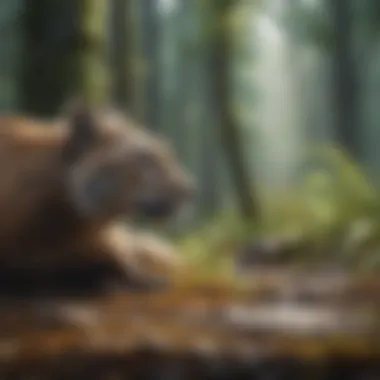Unleashing the Power of Biodiversity: A Comprehensive Guide to Conservation


Overview of the Topic
Biodiversity, the variety of life forms on Earth, encompasses ecosystems, species, and genetic diversity. It is a cornerstone of environmental health and sustainability.
Current Status and Challenges
The current status of global biodiversity faces escalating threats due to human activities such as habitat destruction, pollution, climate change, and invasive species introduction. These factors drive the loss of species and ecosystems, compromising the balance of nature.
Challenges abound in conserving biodiversity, including limited conservation funding, insufficient protected areas, and difficulties in balancing economic development with conservation efforts.
Sustainable Solutions
Sustainable solutions to protect biodiversity include establishing protected areas, sustainable land-use practices, conservation breeding programs, and community engagement in conservation efforts. By promoting sustainable resource management and supporting biodiversity-friendly practices, we can mitigate the impact of human activities on the environment.
Several successful case studies demonstrate the effectiveness of sustainable practices in biodiversity conservation, highlighting the positive outcomes of ecosystem restoration, species recovery, and community involvement.
Impact and Importance
The impact of biodiversity loss extends beyond ecological consequences, influencing human well-being, economies, and future generations. Deteriorating biodiversity can disrupt ecosystem services, destabilize food systems, and heighten vulnerability to natural disasters.
Conservation efforts play a pivotal role in safeguarding ecosystems, ensuring sustainable resource use, and fostering resilience in the face of environmental challenges. Recognizing the intrinsic value of biodiversity underscores the urgency of conservation actions for the benefit of present and future generations.
Understanding Biodiversity
Understanding Biodiversity is a crucial focal point in this article about how to assist biodiversity. By delving into the realm of biodiversity, readers can grasp the intricate web of life forms and ecosystems that coexist on our planet. Understanding the various levels of biodiversity, including ecosystem diversity, species diversity, and genetic diversity, provides a profound insight into the functioning of natural systems and the importance of preserving them for environmental balance and sustainability.
Definition and Importance of Biodiversity
Ecosystem Diversity
Ecosystem Diversity embodies the variety of ecosystems present on Earth, ranging from forests to deserts. This diversity is vital as each ecosystem plays a distinct role in supporting life forms and maintaining ecological balance. Understanding Ecosystem Diversity underscores the need to protect different habitats to ensure the survival of diverse species and the overall health of our planet. Although Ecosystem Diversity offers resilience to environmental changes, human activities threaten its stability, making conservation efforts crucial.
Species Diversity
Species Diversity refers to the richness and abundance of different species within an ecosystem. The preservation of Species Diversity is essential for ecosystem resilience and functionality. Each species contributes uniquely to ecosystem services, such as pollination and nutrient cycling. Recognizing the importance of Species Diversity prompts conservation actions to safeguard endangered species and their habitats. The loss of Species Diversity can disrupt ecosystems and undermine their capacity to adapt to environmental challenges.
Genetic Diversity


Genetic Diversity encompasses the genetic variation within and between species. This diversity is the raw material for adaptation and evolution, enabling populations to withstand environmental changes. Genetic Diversity is vital for species survival, as it enhances their resilience to diseases and ensures genetic variability for future generations. Understanding Genetic Diversity sheds light on the significance of preserving diverse gene pools to maintain healthy populations and biodiversity. Human activities, like habitat destruction and fragmentation, pose threats to Genetic Diversity, necessitating conservation measures for its protection.
The Role of Biodiversity in Ecosystem Functioning
Ecosystem Services
Ecosystem Services are the benefits that ecosystems provide to humans and other organisms, such as clean water, air purification, and soil fertility. These services are indispensable for human well-being, food security, and economic prosperity. Understanding the role of Ecosystem Services underscores the intrinsic link between healthy ecosystems and human welfare. Conserving ecosystems, responsible for providing essential services, is vital for sustainable development and biodiversity preservation.
Food Security
Food Security is achieved when all people, at all times, have physical, social, and economic access to sufficient, safe, and nutritious food. Biodiversity plays a crucial role in ensuring Food Security by providing a diverse range of crops, livestock, and fish species for human consumption. Sustainable agricultural practices that support biodiversity contribute to food diversity, resilience to pests and diseases, and nutrition. Recognizing the interconnection between biodiversity and food production highlights the importance of protecting natural resources and adopting sustainable food systems.
Climate Regulation
Climate Regulation refers to the capacity of ecosystems to regulate climate patterns by sequestering carbon, moderating temperatures, and influencing precipitation. Biodiversity conservation is essential for maintaining stable climate conditions and mitigating climate change impacts. Healthy ecosystems, rich in biodiversity, contribute to carbon sequestration and adaptation to climate variability. Understanding the role of biodiversity in Climate Regulation underscores the urgency of conserving natural habitats, reducing deforestation, and implementing climate-friendly practices to combat global warming and its consequences.
Individual Actions
When it comes to biodiversity preservation, individual actions play a pivotal role. These actions encompass a range of sustainable practices that individuals can adopt in their daily lives to support biodiversity conservation. By making conscientious choices in areas such as consumption, waste management, and community engagement, individuals contribute significantly to the larger goal of environmental sustainability.
Sustainable Consumption Habits
Support Local and Sustainable Products
Supporting local and sustainable products is essential for reducing the carbon footprint associated with transporting goods over long distances. By choosing locally sourced products, individuals help minimize greenhouse gas emissions and support local economies. Additionally, opting for sustainable products encourages environmentally friendly practices in production and ensures the preservation of natural resources for future generations.
Reduce, Reuse, Recycle
Embracing the principles of reduce, reuse, and recycle is crucial in minimizing waste generation and promoting a circular economy. By reducing unnecessary consumption, reusing items, and recycling materials, individuals can lower their environmental impact significantly. These practices conserve resources, reduce energy consumption, and mitigate the burden on landfills, thus contributing to biodiversity conservation.
Minimize Plastic Usage
Minimizing plastic usage is paramount in combating plastic pollution, a significant threat to biodiversity. Single-use plastics pose severe risks to marine life, terrestrial ecosystems, and human health. By opting for alternatives to plastic, such as reusable containers and biodegradable materials, individuals can limit plastic pollution and safeguard biodiversity from the harmful effects of plastic waste.
Promoting Biodiversity in Your Community
Planting Native Species


Introducing native plant species to local habitats enhances biodiversity by providing food and shelter for indigenous wildlife. Native plants are well-adapted to the ecosystem, requiring less maintenance and water than exotic species. By landscaping with native flora, individuals can create biodiverse green spaces that support pollinators, birds, and other wildlife, contributing to a harmonious coexistence between humans and nature.
Creating Wildlife Habitats
Creating wildlife habitats in urban and suburban areas is crucial for offsetting habitat loss due to development. By incorporating features like bird feeders, bat boxes, and pollinator gardens, individuals can attract diverse wildlife to their surroundings. Establishing wildlife-friendly environments fosters ecological balance, enhances urban biodiversity, and provides opportunities for firsthand wildlife observation and appreciation.
Participating in Conservation Programs
Engaging in conservation programs allows individuals to contribute directly to biodiversity protection efforts. By volunteering with local conservation organizations or participating in citizen science projects, individuals can actively participate in conservation initiatives and community stewardship. These programs offer valuable learning experiences, foster a sense of environmental responsibility, and empower individuals to make a tangible difference in safeguarding biodiversity for future generations.
Advocacy and Policy Initiatives
In this section on Advocacy and Policy Initiatives, we delve into the crucial role that advocacy and policy play in ensuring biodiversity conservation and environmental sustainability. By advocating for meaningful policies, individuals and communities can make a significant impact on preserving our ecosystems and biodiversity. Supporting conservation organizations is essential as they serve as the frontline defenders of wildlife and habitats. Through donating to conservation groups, individuals can provide crucial financial support that aids in various conservation efforts, such as protecting endangered species, preserving vital habitats, and implementing essential conservation projects. Donating to conservation groups not only helps in funding important initiatives but also raises awareness about the importance of biodiversity conservation.
Volunteering for wildlife protection is another integral aspect of supporting conservation organizations. By giving their time and effort, individuals can directly contribute to activities such as animal rescue, habitat restoration, and wildlife monitoring. Volunteering offers a hands-on approach to conservation, allowing participants to experience the challenges and rewards of working towards biodiversity protection firsthand. It fosters a sense of connection to nature and wildlife, inspiring a deeper commitment to conservation efforts.
Advocating for environmental policies is a powerful way to effect systemic change and address larger threats to biodiversity. By lobbying for laws and regulations that promote conservation, individuals can influence decision-makers and drive positive environmental outcomes. Advocating for environmental policies involves engaging with legislators, participating in public consultations, and raising awareness about the need for sustainable practices. It is a proactive approach to shaping a more environmentally conscious society, ensuring the protection of biodiversity for future generations.
Supporting Conservation Organizations]
Donating to Conservation Groups plays a crucial role in bolstering conservation efforts and upholding biodiversity. By contributing financial resources, individuals can support the vital work of conservation organizations in safeguarding at-risk wildlife and ecosystems. The act of donating not only provides essential funding for conservation projects but also helps raise public awareness about the importance of biodiversity preservation. Donations enable organizations to carry out critical activities such as scientific research, habitat restoration, and community engagement, contributing to the overall conservation of biodiversity.
Volunteering for Wildlife Protection is a hands-on and impactful way to support conservation organizations. By dedicating their time and skills to wildlife protection endeavors, volunteers can directly contribute to activities such as wildlife monitoring, rescue operations, and habitat restoration. Volunteering offers individuals a firsthand experience of conservation work, fostering a deeper connection to nature and wildlife. It also provides an opportunity to learn about conservation challenges and gain valuable skills that can be applied to future conservation efforts.
Advocating for Environmental Policies is instrumental in influencing legislative decisions that impact biodiversity conservation. By advocating for environmentally friendly policies, individuals can help shape the legal framework that governs conservation efforts. Advocacy involves engaging with policymakers, participating in advocacy campaigns, and mobilizing public support for conservation initiatives. Through advocacy, individuals can amplify their voice and contribute to driving positive change in environmental policy. Advocating for environmental policies is a strategic way to promote sustainable practices, protect natural resources, and ensure the long-term viability of biodiversity.
Influencing Government Policies
Participating in Advocacy Campaigns can be a powerful way to influence government policies and drive positive change for biodiversity conservation. By joining advocacy campaigns, individuals can connect with like-minded advocates, amplify their voices, and raise awareness about key conservation issues. Participating in campaigns often involves activities such as signing petitions, attending rallies, and engaging with policymakers. Advocacy campaigns create a collective momentum for change, urging decision-makers to prioritize environmental protection and biodiversity conservation.
Contacting Elected Representatives is a direct and effective way to communicate concerns and priorities related to biodiversity conservation. By reaching out to elected officials, individuals can share their perspectives on conservation policies, seek support for conservation initiatives, and advocate for stronger environmental regulations. Contacting elected representatives fosters a dialogue between constituents and policymakers, informing decision-makers about the importance of biodiversity preservation and encouraging them to take meaningful action. It is a proactive approach to influencing government policies and advancing conservation agendas.
Supporting Wildlife Protection Legislation is essential for establishing robust legal frameworks that safeguard biodiversity. By actively supporting legislation that protects wildlife, habitats, and ecosystems, individuals can contribute to creating a more sustainable future. Wildlife protection legislation addresses critical issues such as poaching, habitat destruction, and species conservation. By supporting relevant laws and policies, individuals can bolster enforcement efforts, promote conservation practices, and ensure the continued existence of vulnerable species. Supporting wildlife protection legislation is a vital step in securing the preservation of biodiversity and ensuring the health of our natural environment.
Sustainable Land Use Practices
Sustainable Land Use Practices play a crucial role in this article by emphasizing the significance of responsible land management for biodiversity preservation and environmental conservation. These practices involve implementing strategies that ensure the long-term sustainability of natural resources and ecosystems. By adopting Sustainable Land Use Practices, individuals and communities can minimize environmental degradation, preserve biodiversity, and promote ecological resilience. Conserving natural habitats through sustainable land use is essential for maintaining ecosystem balance, supporting wildlife populations, and safeguarding essential ecosystem services.


Preserving Natural Habitats
Creating Protected Areas
Creating Protected Areas is a key aspect of biodiversity conservation as it involves designating specific regions for safeguarding native flora and fauna. These areas serve as havens for endangered species, allowing them to thrive without human interference. The establishment of Protected Areas helps protect biodiversity hotspots, fragile ecosystems, and critical habitats. By restricting human activities in these areas, biodiversity preservation is enhanced, and natural processes can occur undisturbed. Despite their significance, challenges such as resource constraints and conflicting land-use interests may hinder the establishment and effectiveness of Protected Areas. Mitigating these challenges through strategic planning and stakeholder engagement is crucial for the long-term success of Protected Areas.
Restoring Degraded Lands
Restoring Degraded Lands is essential for ecosystem recovery and enhancing biodiversity. This practice involves rehabilitative efforts in areas that have been impacted by human activities such as deforestation, mining, or pollution. By restoring degraded lands, the ecological functions and services of these areas can be reinstated, promoting habitat connectivity and species resilience. Restoring degraded lands not only benefits biodiversity but also contributes to carbon sequestration, soil health improvement, and water quality enhancement. Despite its positive outcomes, the restoration process may be time-consuming, resource-intensive, and require long-term monitoring to ensure ecosystem resilience.
Implementing Sustainable Agriculture
Implementing Sustainable Agriculture is a fundamental component of biodiversity conservation and sustainable land use. Sustainable agricultural practices prioritize environmental stewardship, social responsibility, and economic viability. By incorporating agroecological principles, such as crop diversification, conservation tillage, and integrated pest management, sustainable agriculture can enhance soil fertility, reduce chemical inputs, and preserve biodiversity. Sustainable agriculture promotes ecosystem resilience, supports pollinator populations, and mitigates negative environmental impacts associated with conventional farming practices. However, transitioning to sustainable agriculture may pose challenges related to knowledge dissemination, access to resources, and market demand for sustainably produced goods. Education, policy support, and stakeholder collaboration are vital for promoting sustainable agriculture and its benefits for biodiversity conservation.
Education and Awareness
In this article, the focus shifts towards Education and Awareness, crucial elements in the quest to preserve biodiversity. Education plays a pivotal role in shaping mindsets and behavior towards the environment. It empowers individuals with knowledge about the significance of biodiversity and encourages responsible decision-making. Awareness complements education by disseminating information to broader audiences, sparking interest, and instigating action. When these two factors converge, a ripple effect ensues, leading to a more informed and environmentally conscious society.
Promoting Biodiversity Education
School Programs:
School Programs are key facilitators of biodiversity education. They provide structured platforms within educational institutions, integrating environmental lessons into curricula. The immersive nature of School Programs ensures that students receive firsthand exposure to biodiversity concepts, fostering a deeper understanding and appreciation for the natural world. The interactive methods employed in School Programs make learning engaging and impactful, motivating students to become advocates for biodiversity conservation. Despite their effectiveness, School Programs may face constraints such as limited resources and time allocation, hindering comprehensive coverage of biodiversity topics in some educational settings.
Community Workshops:
Community Workshops promote biodiversity education outside formal academic environments. These interactive sessions bring together community members to discuss and engage with environmental issues collectively. The participatory nature of Community Workshops encourages collaborative learning and knowledge exchange, empowering individuals to take ownership of local conservation efforts. By fostering a sense of community responsibility, these workshops can catalyze grassroots movements towards biodiversity conservation. However, logistical challenges in organizing such workshops and ensuring sustained community participation pose significant hurdles to their widespread implementation.
Public Awareness Campaigns:
Public Awareness Campaigns serve as catalyzers for widespread understanding and engagement on biodiversity conservation. Through various media channels, these campaigns disseminate information, raise consciousness, and inspire action among diverse audiences. The strategic messaging and creative approaches employed in Public Awareness Campaigns capture public attention and fuel momentum towards environmental stewardship. Nevertheless, the efficacy of these campaigns hinges on resource allocation, audience segmentation, and the ability to drive behavioral change effectively.
Raising Awareness on Conservation Issues
Media Outreach:
Media Outreach leverages traditional and digital media platforms to raise awareness on conservation issues. By collaborating with media outlets, conservation organizations amplify their messaging, reaching a wider audience and inspiring public interest. The visual and narrative impact of media coverage can create a sense of urgency around conservation matters, mobilizing support and advocacy for biodiversity protection. However, the challenge lies in ensuring accurate and balanced portrayal of complex conservation issues amidst competing media narratives.
Social Media Campaigns:
Social Media Campaigns harness the power of digital platforms to engage audiences in conservation discourse. These campaigns leverage interactive content, storytelling, and user participation to foster community dialogue and mobilize online activism. The real-time nature of social media enables instant engagement and virality, propelling conservation messages to global audiences. Yet, maintaining algorithmic visibility, combating misinformation, and fostering meaningful online interactions pose ongoing challenges in the realm of social media conservation advocacy.
Engaging with Schools and Universities:
Engaging with Schools and Universities fosters partnerships between conservation organizations and educational institutions. By integrating conservation perspectives into academic programs, students are exposed to real-world conservation practices and research, nurturing a new generation of conservation leaders. The collaborative initiatives between academia and conservation bodies enrich learning experiences and catalyze innovative conservation solutions. However, establishing sustainable collaborations, aligning curriculum goals, and balancing academic priorities remain focal points in optimizing the impact of such engagements.



